Fish Teeth Sr Isotope Stratigraphy and Nd Isotope Variations: New Insights on REY Enrichments in Deep-Sea Sediments in the Pacific
Abstract
:1. Introduction
2. Study Area and Methods
2.1. Study Area and Samples
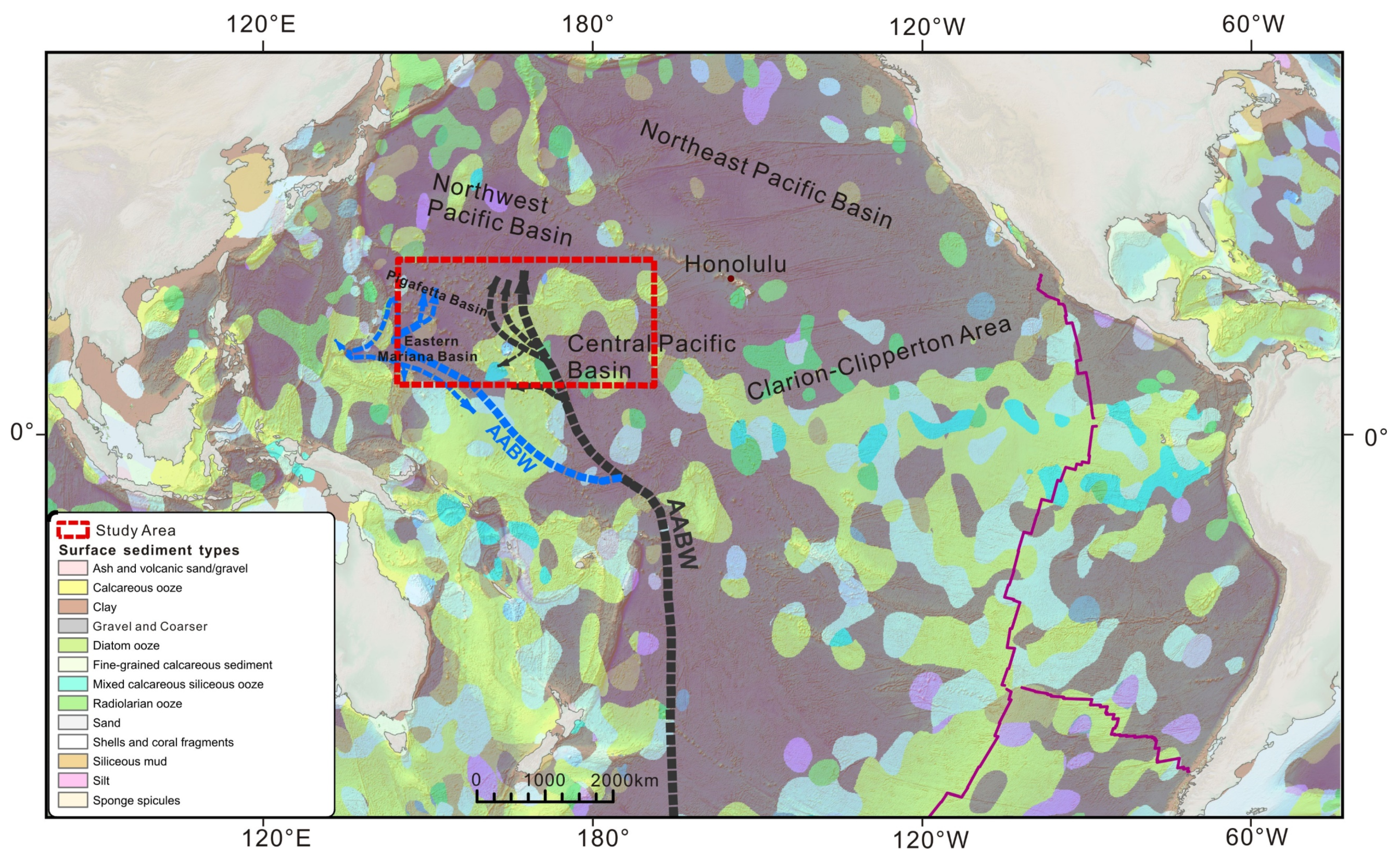
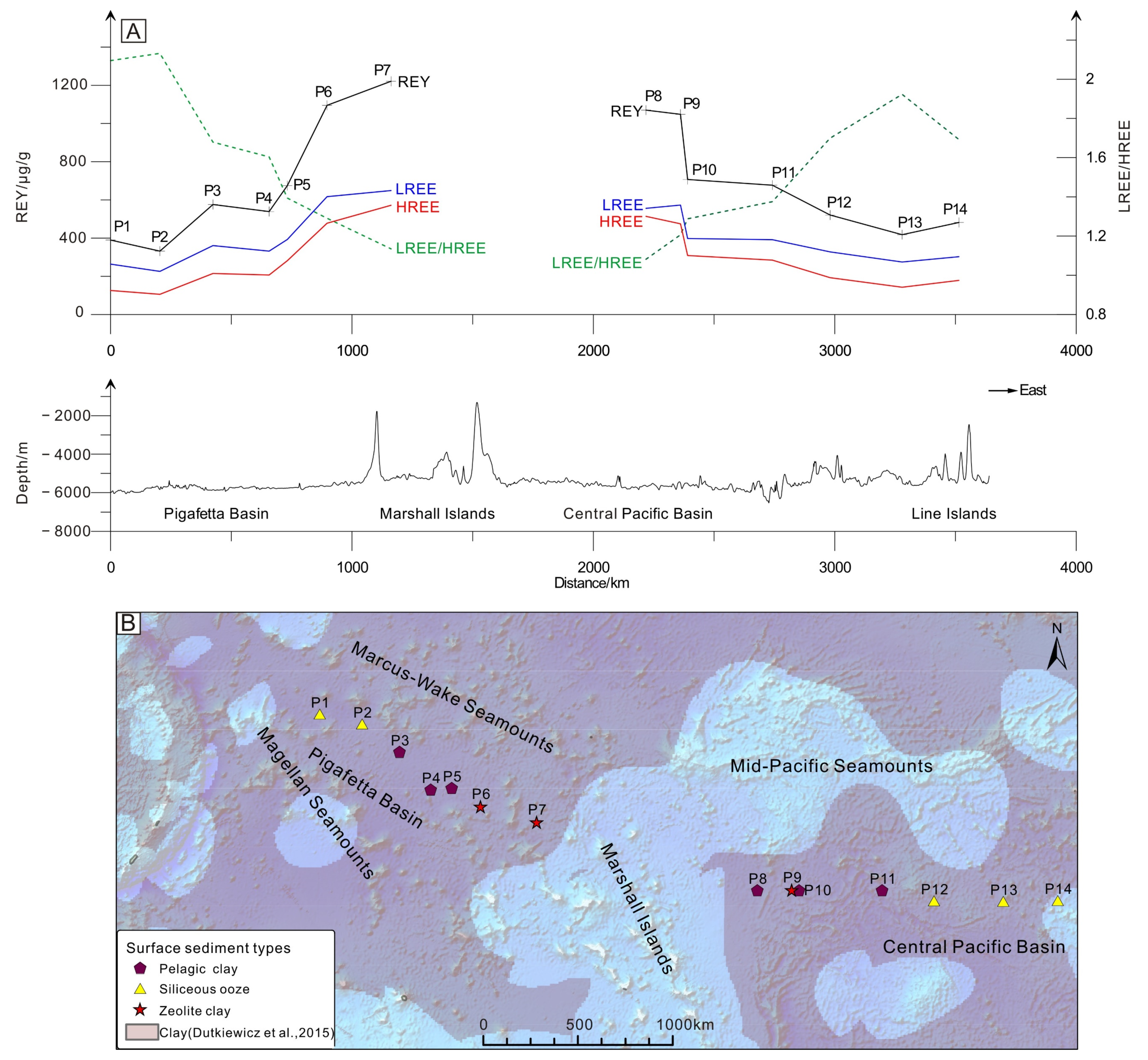
| Core | Sediment Type | REY (μg/g) | LREE (μg/g) | HREE (μg/g) | Depth (m) | Length (cm) |
|---|---|---|---|---|---|---|
| P1 | Siliceous ooze | 390 | 264 | 126 | −5877 | 834 |
| P2 | Siliceous ooze | 332 | 226 | 106 | −5677 | 720 |
| P3 | Pelagic red clay | 576 | 361 | 215 | −5747 | 605 |
| P4 | Pelagic red clay | 539 | 332 | 207 | −5773 | 1445 |
| P5 | Pelagic red clay | 675 | 393 | 282 | −5696 | 732 |
| P6 | Zeolite clay | 1095 | 617 | 478 | −5368 | 715 |
| P7 | Zeolite clay | 1221 | 649 | 572 | −5163 | 802 |
| P8 | Pelagic red clay | 707 | 398 | 309 | −5495 | 765 |
| P9 | Pelagic red clay | 1070 | 556 | 514 | −5667 | 880 |
| P10 | Zeolite clay | 1048 | 573 | 475 | −5613 | 720 |
| P11 | Pelagic red clay | 677 | 392 | 285 | −5635 | 860 |
| P12 | Siliceous ooze | 521 | 328 | 193 | −5293 | 830 |
| P13 | Siliceous ooze | 418 | 275 | 143 | −5177 | 634 |
| P14 | Siliceous ooze | 482 | 303 | 179 | −5620 | 826 |
2.2. Major and Trace Elements
2.3. In Situ Sr and Nd Isotopes
3. Results
3.1. REY Characteristics of Surface Sediments
3.2. Vertical Distributions of REY
3.3. Fish Teeth Sr Isotopic Compositions
3.4. Fish Teeth Nd Isotopic Compositions
4. Discussion
4.1. Distribution of REY-Rich Sediments in the Central and Western Pacific
4.2. Dating REY-Rich Sediments
4.3. Antarctic Bottom Water (AABW) and REY Enrichment
5. Conclusions
Author Contributions
Funding
Institutional Review Board Statement
Informed Consent Statement
Data Availability Statement
Acknowledgments
Conflicts of Interest
References
- Chakhmouradian, A.R.; Wall, F. Rare Earth Elements: Minerals, Mines, Magnets (and More). Elements 2012, 8, 333–340. [Google Scholar] [CrossRef]
- Hatch, G.P. Dynamics in the Global Market for Rare Earths. Elements 2012, 8, 341–346. [Google Scholar] [CrossRef]
- Humphries, M. Rare Earth Elements: The Global Supply Chain; Congressional Research Service: Washington, DC, USA, 2010.
- Liu, Y.; Chen, Z.; Yang, Z.; Sun, X.; Zhu, Z.; Zhang, Q. Mineralogical and geochemical studies of brecciated ores in the Dalucao REE deposit, Sichuan Province, southwestern China. Ore Geol. Rev. 2015, 70, 613–636. [Google Scholar] [CrossRef]
- Liu, Y.; Chakhmouradian, A.R.; Hou, Z.; Song, W.; Kynicky, J. Development of REE mineralization in the giant Maoniuping deposit (Sichuan, China): Insights from mineralogy, fluid inclusions, and trace-element geochemistry. Miner. Depos. 2019, 54, 701–718. [Google Scholar] [CrossRef]
- Kato, Y.; Fujinaga, K.; Nakamura, K.; Takaya, Y.; Kitamura, K.; Ohta, J.; Toda, R.; Nakashima, T.; Iwamori, H. Deep-sea mud in the Pacific Ocean as a potential resource for rare-earth elements. Nat. Geosci. 2011, 4, 535–539. [Google Scholar] [CrossRef]
- Yasukawa, K.; Liu, H.J.; Fujinaga, K.; Machida, S.; Haraguchi, S.; Ishii, T.; Nakamura, K.; Kato, Y. Geochemistry and mineralogy of REY-rich mud in the eastern Indian Ocean. J. Asian Earth Sci. 2014, 93, 25–36. [Google Scholar] [CrossRef]
- Gleason, J.D.; Moore, T.C., Jr.; Johnson, T.M.; Rea, D.K.; Owen, R.M.; Blum, J.D.; Pares, J.; Hovan, S.A. Age calibration of piston core EW9709-07 (equatorial central Pacific) using fish teeth Sr isotope stratigraphy. Palaeogeogr. Palaeoclimatol. Palaeoecol. 2004, 212, 355–366. [Google Scholar] [CrossRef]
- Gleason, J.D.; Moore, T.C., Jr.; Rea, D.K.; Johnson, T.M.; Owen, R.M.; Blum, J.D.; Hovan, S.A.; Jones, C.E. Ichthyolith strontium isotope stratigraphy of a Neogene red clay sequence:calibrating eolian dust accumulation rates in the central North Pacific. Earth Planet. Sci. Lett. 2002, 202, 625–636. [Google Scholar] [CrossRef]
- Hess, J.; Stott, L.D.; Bender, M.L.; Kennett, J.P.; Schilling, J.G. The Oligocene marine microfossil record: Age assessments using strontium isotopes. Paleoceanography 1989, 4, 655–680. [Google Scholar] [CrossRef]
- McArthur, J.M.; Burnett, J.; Hancock, J.M. Strontium isotopes at K/T boundary. Nature 1992, 355, 28. [Google Scholar] [CrossRef]
- McArthur, I.M.; Chen, M.; Gale, A.S.; Kenedy, W.J. Strontium isotope stratigraphy in the Late Cretaceous: Numerical calibration of the Sr isotope curve and intercontinental correlations for the Campanian. Paleoceanogr. Paleoclimatol. 1993, 8, 859–873. [Google Scholar] [CrossRef] [Green Version]
- Dingle, R.V.; McArthur, J.M.; Vroon, P. Oligocene and Pliocene interglacial events in the Antarctic Peninsula dated using strontium isotope stratigraphy. J. Geol. Soc. Lond. 1997, 154, 257–264. [Google Scholar] [CrossRef]
- Dingle, R.V.; Lavelle, M. Late Cretaceous–Cenozoic climatic variations of the northern Antarctic Peninsula: New geochemical evidence and review. Palaeogeogr. Palaeoclimatol. Palaeoecol. 1998, 141, 215–232. [Google Scholar] [CrossRef]
- Crame, A.J.; McArthur, J.M.; Pirrie, D.; Riding, J.B. Strontium isotope correlation of the basal Maastrichtian stage in Antarctica to the European and U.S. standard biostratigraphic schemes. J. Geol. Soc. Lond. 1999, 156, 957–964. [Google Scholar] [CrossRef]
- Arrhenius, G.; Bramlette, M.N.; Piciotto, E. Localization of radioactive and stable heavy nuclides in ocean sediments. Nature 1957, 180, 85–86. [Google Scholar] [CrossRef]
- Wright, J.; Schrader, H.; Holser, W.T. Paleoredox variations in ancient oceans recorded by rare earth elements in fossil apatite. Geochim. Cosmochim. Acta 1987, 51, 631–644. [Google Scholar] [CrossRef]
- Snoeckx, H.; Rea, D.K.; Jones, C.E.; Ingram, B.L. Eolian and Silica Deposition in the Central North Pacific: Results from Leg 145 sites 885/886. In Proceedings of the Ocean Drilling Program. Scientific Results; Rea, D.K., Basov, I.A., Scholl, D.W., Allan, J.F., Eds.; Ocean Drilling Progarm, Texam A&M University: College Station, TX, USA, 1995; Volume 145, pp. 219–230. Available online: http://www-odp.tamu.edu/publications/145_SR/VOLUME/CHAPTERS/sr145_14.pdf (accessed on 19 November 2021).
- McArthur, J.M.; Howarth, R.J.; Bailey, T.R. Strontium isotope stratigraphy: LOWESS Version 3: Best fit to the marine Sr-isotope curve for 0–509 Ma and accompanying look-up table for deriving numerical ages. J. Geol. 2001, 109, 155–170. [Google Scholar] [CrossRef] [Green Version]
- Palmer, M.R.; Elderfield, H. Variations in the Nd isotopic composition of foraminifera from Atlantic Ocean sediments. Earth Planet. Sci. Lett. 1985, 73, 299–305. [Google Scholar] [CrossRef]
- Goldberg, E.D.; Koide, M.; Schmitt, R.A.; Smith, J. Rare earth distributions in the marine environment. J. Geophys. Res. 1963, 68, 4209–4217. [Google Scholar] [CrossRef]
- Staudigel, H.; Doyle, P.; Zindler, A. Sr and Nd isotope systematics in fish teeth. Earth Planet. Sci. Lett. 1985, 76, 45–56. [Google Scholar] [CrossRef]
- Piepgras, D.J.; Wasserburg, G.J. Nd isotopic variations in seawater. Earth Planet. Sci. Lett. 1980, 50, 128–138. [Google Scholar] [CrossRef]
- Piepgras, D.J.; Wasserburg, G.J. Isotopic composition of neodymium in waters from the Drake Passage. Science 1982, 217, 207–214. [Google Scholar] [CrossRef] [PubMed]
- Dutkiewicz, A.; Müller, R.D.; O’Callaghan, S.; Jónasson, H. Census of seafloor sediments in the world’s ocean. Geology 2015, 43, 795–798. [Google Scholar] [CrossRef]
- Kawabe, M.; Fujio, S.; Yanagimoto, D. Deep-water circulation at low latitudes in the western North Pacific. Deep Sea Res. Part I Oceanogr. Res. Pap. 2003, 50, 631–656. [Google Scholar] [CrossRef]
- Yang, Y.H.; Wu, F.Y.; Xie, L.W.; Yang, J.H.; Zhang, Y.B. In-situ Sr isotopic measurement of natural geological samples by LA-MC-ICP-MS. Acta Petrol. Sin. 2009, 25, 3431–3441. (In Chinese) [Google Scholar]
- Hou, K.J.; Qin, Y.; Li, Y.H.; Fan, C.F. In situ Sr-Nd Isotopic Measurement of Apatite Using Laser Ablation Multi-collector Inductively Coupled Plasma-Mass Spectrometry. Rock Miner. Anal. 2013, 32, 547–554. (In Chinese) [Google Scholar]
- Zhang, L.; Ren, Z.Y.; Xia, X.P.; Li, J.; Zhang, Z.F. IsotopeMaker: A Matlab program for isotopic data reduction. Int. J. Mass Spectrom. 2015, 392, 118–124. (In Chinese) [Google Scholar] [CrossRef] [Green Version]
- Wasserburg, G.J.; Jacobsen, S.B.; DePaolo, D.J.; McCulloch, M.T.; Wen, T. Precise determination of SmNd ratios, Sm and Nd isotopic abundances in standard solutions. Geochim. Cosmochim. Acta 1981, 45, 2311–2323. [Google Scholar] [CrossRef]
- Yang, Y.H.; Wu, F.Y.; Yang, J.H.; Chew, D.M.; Xie, L.W.; Chu, Z.Y.; Zhang, Y.B.; Huang, C. Sr and Nd isotopic compositions of apatite reference materials used in U–Th–Pb geochronology. Chem. Geol. 2014, 385, 35–55. (In Chinese) [Google Scholar] [CrossRef]
- Haskin, M.A.; Haskin, L.A. Rare earths in European shales: A redetermination. Science 1966, 154, 507–509. [Google Scholar] [CrossRef]
- Mead, G.A.; Hodell, D.A. Controls on the 87Sr/86Sr composition of seawater from the middle Eocene to Oligocene: Hole 689B, Maud rise, Antarctica. Paleoceanography 1995, 10, 327–346. [Google Scholar] [CrossRef]
- Hodell, D.A. Variations in the strontium isotopic ratio of seawater during the Miocene: Stratigraphic and geochemical implications. Paleoceonography 1994, 9, 405–426. [Google Scholar] [CrossRef]
- Hodell, D.A.; Mueller, P.A.; Garrido, J.R. Variations in the strontium isotopic composition of seawater during the Neogene. Geology 1991, 19, 24–27. [Google Scholar] [CrossRef]
- Dubois, N.; Mitchell, N.C. Large-scale sediment redistribution on the equatorial Pacific seafloor. Deep Sea Res. Part I Oceanogr. Res. Pap. 2012, 69, 51–61. [Google Scholar] [CrossRef]
- Veizer, J.; Compston, W. 87Sr/86Sr composition of seawater during the Phanerozoic. Geochim. Cosmochim. Acta 1947, 38, 1461–1484. [Google Scholar] [CrossRef]
- Vérard, C.; Flores, K.; Stampfli, G. Geodynamic reconstructions of the South America–Antarctica plate system. J. Geodyn. 2012, 53, 43–60. [Google Scholar] [CrossRef]
- Barker, P.F.; Burrell, J. The opening of Drake Passage. Mar. Geol. 1977, 25, 15–34. [Google Scholar] [CrossRef]
- Zachos, J.; Pagani, M.; Sloan, L.; Thomas, E.; Billups, K. Trends, Rhythms, and Aberrations in Global Climate 65 Ma to Present. Science 2001, 292, 686–693. [Google Scholar] [CrossRef] [PubMed]
- Keller, G.; Barron, J. Paleoceaanographic implications of Miocene deep-sea hiatuses. Geol. Soc. Am. Bull. 1983, 94, 590–613. [Google Scholar] [CrossRef]
- Barron, J.; Keller, G. Widespread Miocene deep-sea hiatuses: Coincidence with periods of global cooling. Geology 1982, 10, 577–581. [Google Scholar] [CrossRef]
- Albarède, F.; Goldstein, S.L. World map of Nd isotopes in sea-floor ferromanganese deposits. Geology 1992, 20, 761–763. [Google Scholar] [CrossRef]
- Jones, C.E.; Halliday, A.N.; Rea, D.K.; Owen, R.M. Neodymium isotopic variations in North Pacific modern silicate sediment and the insignificance of detrital REE contributions to seawater. Earth Planet. Sci. Lett. 1994, 127, 55–66. [Google Scholar] [CrossRef] [Green Version]
- Zhao, K.D.; Jiang, S.Y.; Zheng, X.Y.; Chen, T.Y.; Ling, F.F. Nd isotope evolution of ocean waters and implications for paleo-ocean circulation. Earth Sci. Front. 2009, 16, 160–171. (In Chinese) [Google Scholar]
- Kawabe, M.; Yanagimoto, D.; Kitagawa, S. Variations of deep western boundary currents in the Melanesian Basin in the western North Pacific. Deep Sea Res. Part I Oceanogr. Res. Pap. 2006, 53, 942–959. [Google Scholar] [CrossRef]
- Han, J.; Wu, G.H.; Ye, Y.; Wu, D.D. Geochemical record of bottom water in ferromanganese crusts. Miner. Depos. 2006, 25, 620–628. (In Chinese) [Google Scholar]
- De Carlo, E.H. Paleoceanographic implication of rare earth element variability in a marine Fe-Mn crust from the Hawaiian Archipelago. Mar. Geol. 1991, 98, 449–467. [Google Scholar] [CrossRef]
- Banakar, V.K.; Pattan, J.N.; Mudholkar, A.V. Palaeoceano graphic conditions during the formation of a ferromanganese curst from the Afanasiy-Nikitin seamount, North Central Indian Ocean: Geochemical evidence. Mar. Geol. 1997, 136, 299–315. [Google Scholar] [CrossRef]
- Rogers, A.D. The biology of seamounts. Adv. Mar. Biol. 1994, 30, 305–350. [Google Scholar]
- Rogers, A.D. The biology of seamounts: 25 Years on. Adv. Mar. Biol. 2018, 79, 137–224. [Google Scholar]
- Hein, J.R.; Yeh, H.W.; Gunn, S.H.; Sliter, W.V.; Benninger, L.M.; Wang, C.H. Two major Cenozoic episodes of phosphatization recorded in equatorial Pacific seamount deposits. Paleoceanography 2003, 8, 293–311. [Google Scholar] [CrossRef]
- Ohta, J.; Yasukawa, K.; Nozaki, T.; Takaya, Y.; Mimura, K.; Fujinaga, K.; Nakamura, K.; Usui, Y.; Kimura, J.I.; Chang, Q.; et al. Fish proliferation and rare-earth deposition by topographically induced upwelling at the late Eocene cooling event. Sci. Rep. 2020, 10, 1–11. [Google Scholar] [CrossRef]
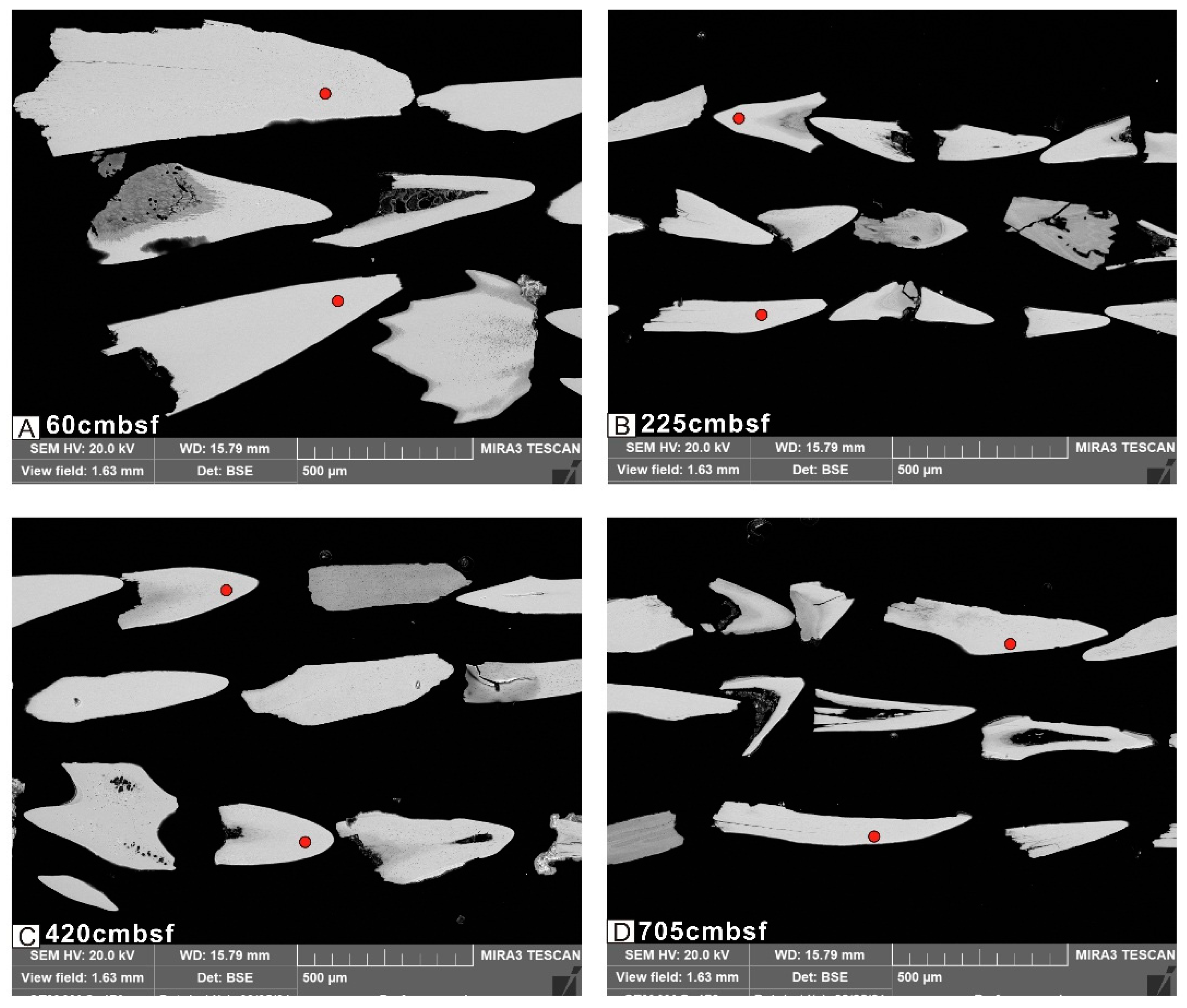
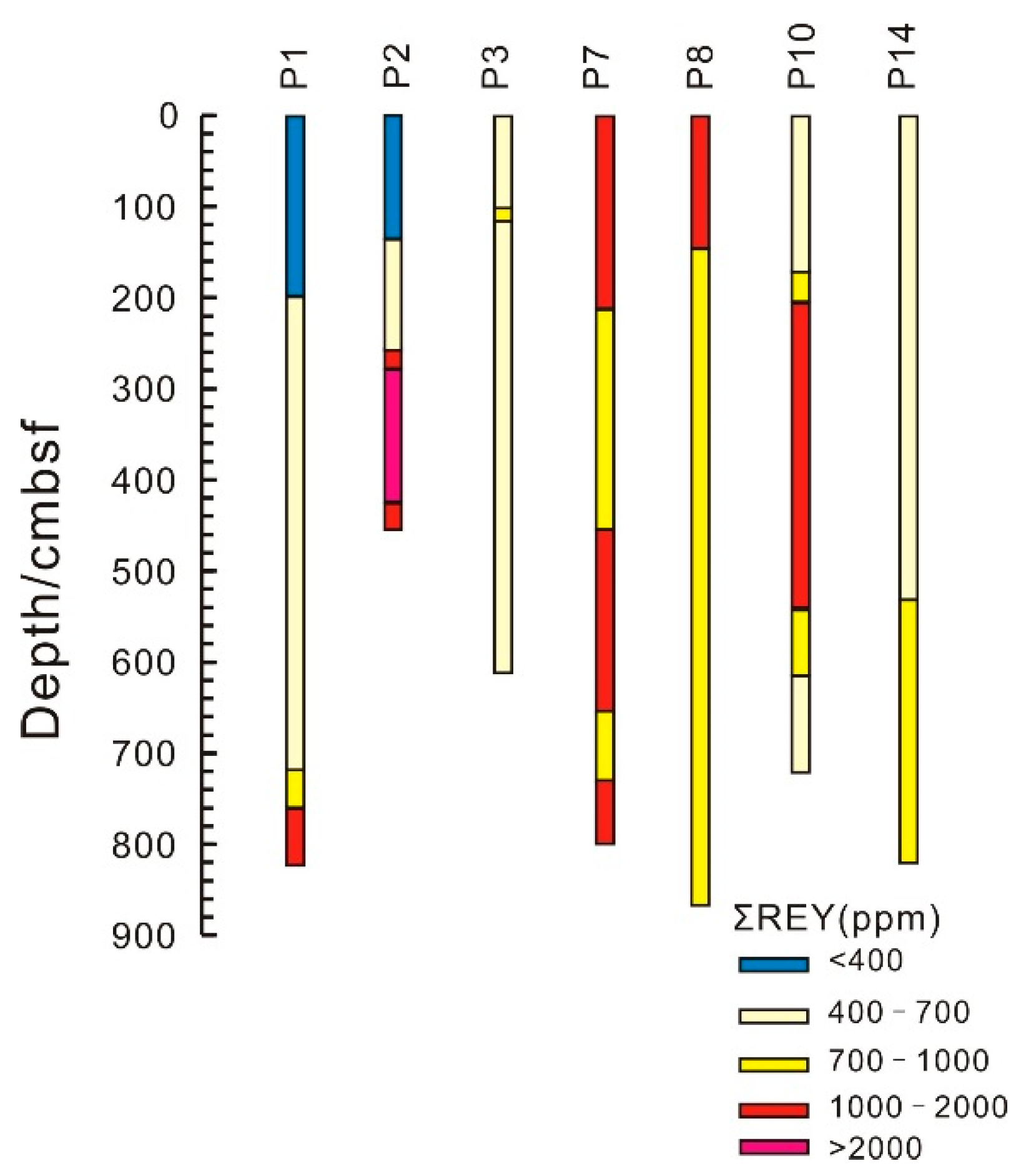

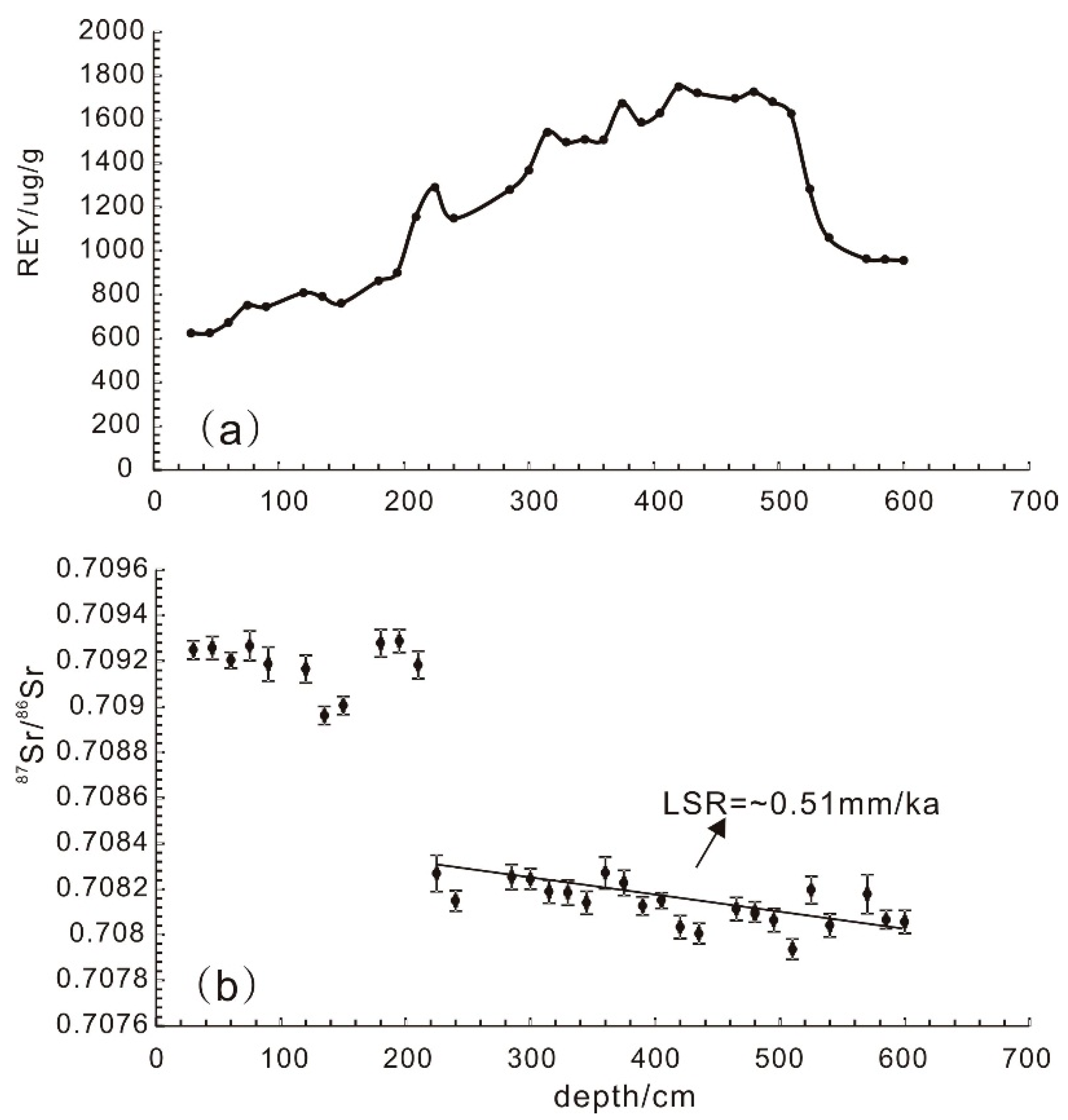

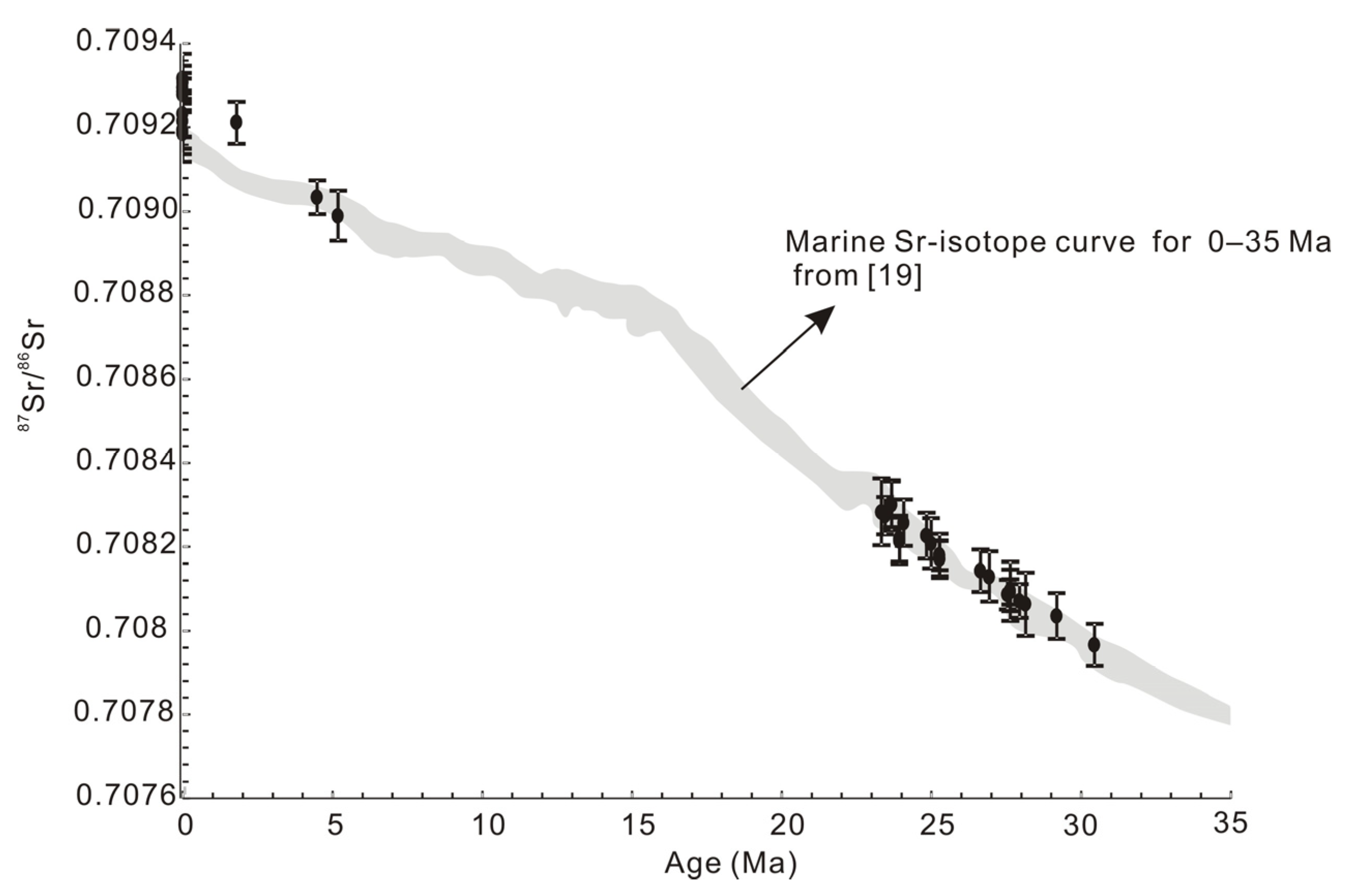

| Depth (cm) | 87Sr/86Sr (corr) | 2σ | Age (Ma) |
|---|---|---|---|
| 30 | 0.709249 | 0.00008 | 0 [19] |
| 30 | 0.709143 | 0.00009 | 0.5 [19] |
| 45 | 0.709257 | 0.00010 | 0 [19] |
| 60 | 0.709158 | 0.00011 | 0 [19] |
| 60 | 0.709204 | 0.00007 | 0 [19] |
| 75 | 0.709267 | 0.00013 | 0 [19] |
| 90 | 0.709187 | 0.00015 | 0 [19] |
| 120 | 0.709165 | 0.00012 | 0 [19] |
| 135 | 0.708961 | 0.00008 | 5.2 [19] |
| 150 | 0.709005 | 0.00008 | 4.5 [19] |
| 180 | 0.709278 | 0.00012 | 0 [19] |
| 195 | 0.709288 | 0.00010 | 0 [19] |
| 210 | 0.709183 | 0.00012 | 1.8 [19] |
| 225 | 0.708124 | 0.00007 | 26.77 [33] |
| 225 | 0.708269 | 0.00016 | 23.71 [33] |
| 240 | 0.708149 | 0.00009 | 25.31 [33] |
| 285 | 0.708426 | 0.00011 | 20.08 [33] |
| 285 | 0.708253 | 0.00011 | 23.36 [34] |
| 300 | 0.708244 | 0.00009 | 23.48 [34] |
| 300 | 0.708275 | 0.00011 | 21.9 [34] |
| 315 | 0.708088 | 0.00011 | 26.29 [33] |
| 315 | 0.708189 | 0.00010 | 23.96 [34] |
| 330 | 0.708235 | 0.00015 | 23.23 [34] |
| 330 | 0.708184 | 0.00011 | 23.96 [34] |
| 345 | 0.708140 | 0.00010 | 25.31 [33] |
| 360 | 0.708271 | 0.00014 | 23.71 [35] |
| 360 | 0.708330 | 0.00010 | 22.61 [35] |
| 375 | 0.708227 | 0.00011 | 24.11 [35] |
| 390 | 0.708126 | 0.00008 | 25.7 [33] |
| 390 | 0.708062 | 0.00012 | 27.67 [33] |
| 405 | 0.708218 | 0.00010 | 24.33 [35] |
| 405 | 0.708150 | 0.00007 | 25.31 [33] |
| 420 | 0.708016 | 0.00007 | 28.68 [33] |
| 420 | 0.708033 | 0.00010 | 28.18 [33] |
| 435 | 0.708005 | 0.00009 | 29.22 [33] |
| 450 | 0.708331 | 0.00013 | 22.61 [35] |
| 465 | 0.708113 | 0.00010 | 26.67 [33] |
| 465 | 0.708370 | 0.00011 | 21.06 [35] |
| 480 | 0.708092 | 0.00014 | 27.46 [33] |
| 480 | 0.708099 | 0.00009 | 26.97 [33] |
| 495 | 0.708187 | 0.00009 | 24.87 [33] |
| 495 | 0.708064 | 0.00010 | 27.67 [33] |
| 510 | 0.708275 | 0.00010 | 23.71 [35] |
| 525 | 0.708196 | 0.00012 | 24.87 [33] |
| 525 | 0.708385 | 0.00011 | 21.27 [35] |
| 540 | 0.708041 | 0.00010 | 27.98 [33] |
| 570 | 0.708178 | 0.00017 | 25.02 [33] |
| 570 | 0.708239 | 0.00014 | 24.22 [35] |
| 585 | 0.708106 | 0.00008 | 26.14 [33] |
| 585 | 0.708066 | 0.00008 | 27.67 [33] |
| 600 | 0.708096 | 0.00007 | 27.07 [33] |
| 600 | 0.708056 | 0.00010 | 27.58 [33] |
| 630 | 0.708254 | 0.00009 | 23.95 [35] |
| 645 | 0.708008 | 0.00009 | 29.22 [33] |
| 660 | 0.708184 | 0.00014 | 26.29 [33] |
| 675 | 0.707960 | 0.00007 | 30.13 [33] |
| 695 | 0.708309 | 0.00012 | 23.03 [35] |
| 705 | 0.708350 | 0.00008 | 21.98 [35] |
| 705 | 0.708477 | 0.00012 | 20.42 [35] |
| 720 | 0.708481 | 0.00010 | 20.82 [35] |
| Depth (cm) | 143Nd/144Nd | 2σ | εNd |
|---|---|---|---|
| 15 | 0.512413 | 0.000039 | −4.40 |
| 30 | 0.512374 | 0.000049 | −5.14 |
| 45 | 0.512415 | 0.000032 | −4.35 |
| 45 | 0.512371 | 0.000054 | −5.21 |
| 45 | 0.512418 | 0.000076 | −4.29 |
| 60 | 0.512309 | 0.000028 | −6.42 |
| 75 | 0.512531 | 0.000037 | −2.09 |
| 75 | 0.512497 | 0.000045 | −2.75 |
| 90 | 0.512533 | 0.000035 | −2.04 |
| 90 | 0.512320 | 0.000041 | −6.20 |
| 105 | 0.512411 | 0.000037 | −4.43 |
| 105 | 0.512372 | 0.000044 | −5.19 |
| 135 | 0.512343 | 0.000077 | −5.76 |
| 135 | 0.512387 | 0.000032 | −4.90 |
| 150 | 0.512335 | 0.000051 | −5.91 |
| 150 | 0.512416 | 0.000027 | −4.34 |
| 165 | 0.512449 | 0.000038 | −3.69 |
| 180 | 0.512436 | 0.000038 | −3.95 |
| 180 | 0.512375 | 0.000029 | −5.13 |
| 195 | 0.512397 | 0.000022 | −4.71 |
| 195 | 0.512408 | 0.000024 | −4.49 |
| 210 | 0.512183 | 0.000066 | −8.88 |
| 210 | 0.512421 | 0.000031 | −4.22 |
| 225 | 0.512124 | 0.000034 | −10.03 |
| 225 | 0.512166 | 0.000032 | −9.21 |
| 225 | 0.512187 | 0.000049 | −8.79 |
| 240 | 0.512136 | 0.000032 | −9.80 |
| 240 | 0.512127 | 0.000169 | −9.97 |
| 255 | 0.512407 | 0.000024 | −4.52 |
| 255 | 0.512155 | 0.000031 | −9.43 |
| 270 | 0.512256 | 0.000039 | −7.45 |
| 285 | 0.512110 | 0.000038 | −10.29 |
| 285 | 0.512250 | 0.000042 | −7.58 |
| 300 | 0.512212 | 0.000029 | −8.31 |
| 300 | 0.512250 | 0.000042 | −7.56 |
| 315 | 0.512256 | 0.000043 | −7.46 |
| 315 | 0.512235 | 0.000034 | −7.86 |
| 330 | 0.512241 | 0.000035 | −7.75 |
| 330 | 0.512180 | 0.000039 | −8.93 |
| 345 | 0.512406 | 0.000047 | −4.53 |
| 360 | 0.512249 | 0.000028 | −7.59 |
| 360 | 0.512269 | 0.000042 | −7.19 |
| 375 | 0.512284 | 0.000042 | −6.90 |
| 375 | 0.512200 | 0.000060 | −8.55 |
| 390 | 0.512369 | 0.000039 | −5.24 |
| 405 | 0.512238 | 0.000038 | −7.80 |
| 405 | 0.512112 | 0.000054 | −10.26 |
| 420 | 0.512264 | 0.000060 | −7.29 |
| 435 | 0.512208 | 0.000048 | −8.39 |
| 435 | 0.512349 | 0.000034 | −5.64 |
| 465 | 0.512236 | 0.000036 | −7.84 |
| 480 | 0.512137 | 0.000045 | −9.78 |
| 495 | 0.512427 | 0.000060 | −4.11 |
| 510 | 0.512491 | 0.000045 | −2.87 |
| 525 | 0.512369 | 0.000020 | −5.25 |
| 540 | 0.512250 | 0.000053 | −7.56 |
| 555 | 0.512187 | 0.000030 | −8.79 |
| 570 | 0.512247 | 0.000065 | −7.64 |
| 570 | 0.512293 | 0.000028 | −6.74 |
| 585 | 0.512373 | 0.000028 | −5.18 |
| 600 | 0.512419 | 0.000036 | −4.27 |
| 600 | 0.512358 | 0.000019 | −5.47 |
| 630 | 0.512348 | 0.000023 | −5.65 |
| 630 | 0.512315 | 0.000023 | −6.30 |
| 660 | 0.512352 | 0.000023 | −5.59 |
| 690 | 0.512352 | 0.000023 | −5.59 |
| 690 | 0.512244 | 0.000049 | −7.69 |
| 705 | 0.512329 | 0.000027 | −6.03 |
Publisher’s Note: MDPI stays neutral with regard to jurisdictional claims in published maps and institutional affiliations. |
© 2021 by the authors. Licensee MDPI, Basel, Switzerland. This article is an open access article distributed under the terms and conditions of the Creative Commons Attribution (CC BY) license (https://creativecommons.org/licenses/by/4.0/).
Share and Cite
Wang, F.; He, G.; Deng, X.; Yang, Y.; Ren, J. Fish Teeth Sr Isotope Stratigraphy and Nd Isotope Variations: New Insights on REY Enrichments in Deep-Sea Sediments in the Pacific. J. Mar. Sci. Eng. 2021, 9, 1379. https://doi.org/10.3390/jmse9121379
Wang F, He G, Deng X, Yang Y, Ren J. Fish Teeth Sr Isotope Stratigraphy and Nd Isotope Variations: New Insights on REY Enrichments in Deep-Sea Sediments in the Pacific. Journal of Marine Science and Engineering. 2021; 9(12):1379. https://doi.org/10.3390/jmse9121379
Chicago/Turabian StyleWang, Fenlian, Gaowen He, Xiguang Deng, Yong Yang, and Jiangbo Ren. 2021. "Fish Teeth Sr Isotope Stratigraphy and Nd Isotope Variations: New Insights on REY Enrichments in Deep-Sea Sediments in the Pacific" Journal of Marine Science and Engineering 9, no. 12: 1379. https://doi.org/10.3390/jmse9121379
APA StyleWang, F., He, G., Deng, X., Yang, Y., & Ren, J. (2021). Fish Teeth Sr Isotope Stratigraphy and Nd Isotope Variations: New Insights on REY Enrichments in Deep-Sea Sediments in the Pacific. Journal of Marine Science and Engineering, 9(12), 1379. https://doi.org/10.3390/jmse9121379





